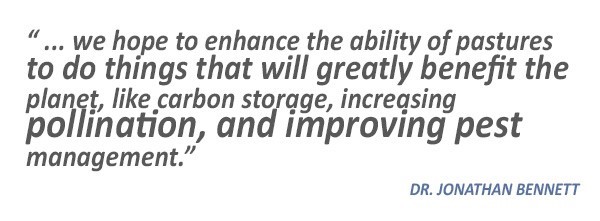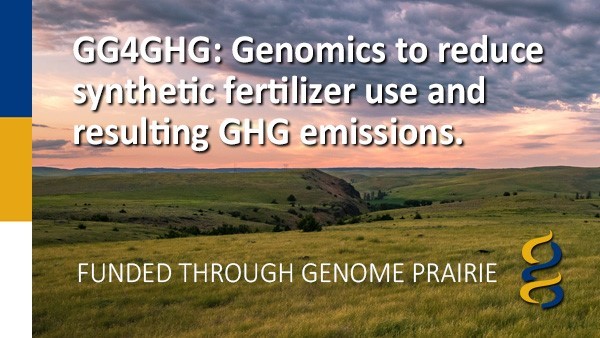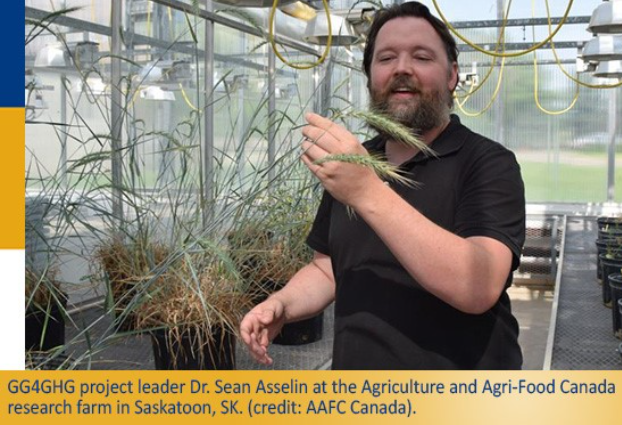The Grasslands Genomic Project, part of Genome Canada’s Climate-Smart Agriculture and Smart Food initiative, is examining the fascinating and delicate grasslands ecosystem, which could hold the key for future food production that generates lesser carbon emissions.
When Dr. Jonathan Bennett, an associate professor at the University of Saskatchewan College of Agriculture and Bioresources, looks out at a grassland field, his eyes often don’t scan the colours representing the plant life. Instead, Bennett, like those who study this threatened ecosystem, sees the entirety of life itself.
“We are losing a lot of grasslands. We lose a fair amount every year,” said Bennett.
Grasslands are diverse ecosystems characterized by vast expanses of grasses, often interspersed with a wide range of plant, animal and insect species. They are expansive but incredibly vulnerable ecosystems and play an essential role in protecting the health of Earth’s health and well-being.
Grasslands are classified into two primary types: temperate and tropical. Tropical grasslands, also known as savannas, are primarily found in regions close to the equator, such as Africa, South America, and Australia. They experience distinct wet and dry seasons, and the vegetation is characterized by a mix of grasses and scattered trees.
Temperate grasslands are found in regions with pronounced seasonal variations, such as the prairies of North America, the steppes of Eurasia, and the pampas of South America. These regions experience cold winters and hot summers, often subjected to periodic droughts. The vegetation in temperate grasslands primarily consists of herbaceous plants, including grasses and forbs. The soil in these regions is typically nutrient-rich, making it suitable for agriculture.
In Canada, grasslands comprise a sizable but confined portion of the Canadian landscape. Aside from small pockets in Ontario and British Columbia, almost all of its grasslands are in the prairie region, stretching from southeast Manitoba to northwest Alberta.
“Historically the greatest abundance of grasslands in Canada are in the southern half of Saskatchewan,” said Bennett. “This province is nearly perfect for these environments. The climate is ideal, and the Rocky Mountains aren’t anywhere close.
“In North America, almost all of the grasslands are in the great plains, and what we have in the prairies represents the northern region of that ecosystem.”
It is estimated that grasslands cover about 26 million acres of land in Canada, roughly the size of Cuba. On the surface, that size seems impressive, but it actually represents a massive ecosystem decline. In 2023, Canada’s grasslands are estimated to be just five per cent of what they were more than 100 years ago.
The loss of these delicate ecosystems has consequences. It means the potential irrevocable loss of plants that could benefit food and medicine production. It means the possible extinction of insects and animals that were once commonplace. The direct consequences are also economic, said Bennett, as grasslands play a big role in support of livestock farmers.
“We still are losing a lot of grasslands to agriculture and urban sprawl. It’s a big concern to the livestock industry.
It’s important to know that hundreds, if not thousands, of individual livestock producers are proud stewards of Canadian grasslands and biodiversity. They’ve done much work for many years to promote and maintain these grasslands because their livelihood depends on its survival.”

In addition to helping to feed the livestock industry, grasslands may play a key role in combating rising levels of carbon dioxide (C02) in the atmosphere and the catastrophic threat of global warming.
Whether temperate or tropical, grasslands function as excellent carbon sinks. They absorb and store substantial amounts of atmospheric carbon dioxide. Deep root systems of grassland plants associated with these ecosystems sequester carbon below ground, making them valuable in the fight against global warming. According to Bennett, grasslands are superior to other natural landscape features, which could include wetlands and forests, for sequestering carbon.
“Unlike forests, grasslands store most of the carbon they capture in the soil. Because it’s kept underground, it’s much more stable and less prone to being re-released into the atmosphere. That’s the problem with forests. When there are large fires, much of the carbon stored in trees is released into the atmosphere when they burn.”
Bennett, along with Dr. Sean Asselin from Agriculture and Agri-Food Canada (Swift Current, SK), lead the Grassland Genomics Project (GG4GHG), a Genome Canada-funded large-scale genomics project. GG4GHG was one of nine national projects successfully submitted to the Climate-Smart Agriculture and Food Systems initiative launched in 2022.
From a genomics perspective, Bennett said the GG4GHG project will focus on three main areas of grasslands to understand how they interact with major life systems, including microbes, animals and insects.
“GG4GHG will be focusing on native and pasture grasslands. Both are distinct but are extremely important for different reasons.
“Pasture grasslands are important because they provide feed for livestock production,” said Bennett. “Native grasslands have great aesthetic and cultural value, especially for many First Nation communities. Additionally, native grasslands have incredible biodiversity.”

The project will be focused on three main areas of research: genotyping native plants, DNA sequencing of soil microbes, and gaining more information on how grassland plants interact with insect populations.
“Genotyping will be very critical by linking native plant genetics to plant function and giving us insight into how they behave. We will seek answers to important questions like, are some species more drought tolerant than others on the Canadian Prairies? Are some species better able to help capture carbon?
“Another critical focus will be microbes in grassland soils. Microbes are nearly unidentifiable without genomics because you can only distinguish and understand them through their DNA. We’ll be using genomics tools to identify microbes belonging to different groups. Because microbes are so important to soil processes, especially for carbon storage, we hope to link microbe DNA signatures to carbon storage to understand how they vary over time. We hope to develop predictive carbon storage models based on the genomic fingerprint of the soils.”
The third major component of the GG4GHG project is the role of insects within grassland systems, specifically how these environments support a variety of pollinators, including bees and butterflies. Insects are essential for pollinating wildflowers, crops, and many fruit-bearing plants, contributing significantly to the success of plants and the biodiversity of plant populations.
“We’ll be using environmental DNA to identify insect populations,” said Bennett. “It’ll be a way of censusing which plant populations or species associate with different kinds of insects like pollinators.
Conversely, the project will also study how grasslands interact with and attract less desirable insect communities, including those considered pests that hurt crops.”
“If we find that some of these pests are associated with particular plants, then it could be beneficial to work on ways that discourage the abundance of those plants in grassland environments, especially if used in agricultural or livestock settings.”
Whether populated with plants and insects that benefit or pest, Bennett said it will be crucial moving forward to ensure grassland environments are not only protected but remain highly diverse.
“Ultimately, I’d like more native plant species in the pasture system. Over the past few years, we’ve gotten a lot better with improved management. We’ve improved at monitoring things like stocking rates [the number of animals grazing on the land] and ensuring the ecosystems aren’t overused.
“At the same time, we’re seeing increased pressure from invasive plant species in grasslands. The problem is that these species can become dominant. When that happens, it can cause the loss of many other plant species. Imagine you have a grassland area with ten different plants, and they do ten different things really well. All of a sudden, there’s just one plant species in the area that does its one thing. Then we end up with grasslands that no longer have a variety of alternative functions or services.”
“Changes in the species of plants have a cascading effect on all the services and functions of a grassland. A plant change will affect insects, affecting animals like birds and mammals. Everything is affected. Even the microbes in the soil.”
By the end of the project, Bennett is hopeful that advances will be made that better protect and enhance future grassland biodiversity.
“Ultimately what we’d like to see this project enhance the biodiversity potential of pasture ecosystems to enhance their functionality. At the same time, we hope to enhance the ability of pastures to do things that will greatly benefit the planet, like carbon storage, increasing pollination, and improving pest management.”
“There’s been a lot of time and effort put into climate change, which is very important. But the fact of the matter is biodiversity is going to be our next big global environmental crisis.
“I can imagine that in the next five to ten years, there will be a vastly increased emphasis on the maintenance and conservation of biodiversity, particularly in science and research. And if this can also help reduce greenhouse gas emissions from agriculture, then we’ll be having an even larger impact.”
Thank you to Genome Prairie for submitting the article and photos.
